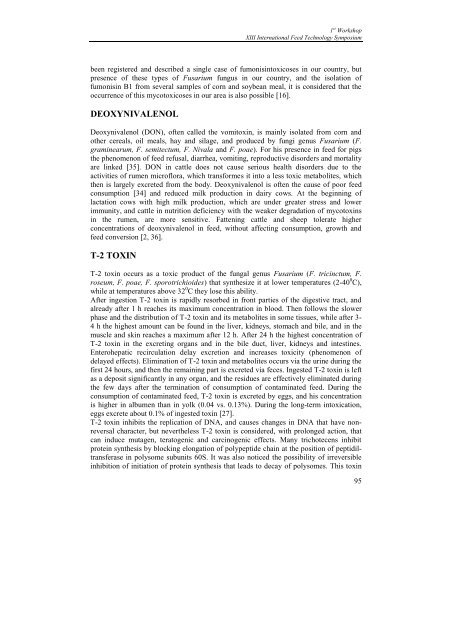Effects of dietary n-3 polyunsaturated fatty acids and ... - FINS
Effects of dietary n-3 polyunsaturated fatty acids and ... - FINS
Effects of dietary n-3 polyunsaturated fatty acids and ... - FINS
You also want an ePaper? Increase the reach of your titles
YUMPU automatically turns print PDFs into web optimized ePapers that Google loves.
1 st WorkshopXIII International Feed Technology Symposiumbeen registered <strong>and</strong> described a single case <strong>of</strong> fumonisintoxicoses in our country, butpresence <strong>of</strong> these types <strong>of</strong> Fusarium fungus in our country, <strong>and</strong> the isolation <strong>of</strong>fumonisin B1 from several samples <strong>of</strong> corn <strong>and</strong> soybean meal, it is considered that theoccurrence <strong>of</strong> this mycotoxicoses in our area is also possible [16].DEOXYNIVALENOLDeoxynivalenol (DON), <strong>of</strong>ten called the vomitoxin, is mainly isolated from corn <strong>and</strong>other cereals, oil meals, hay <strong>and</strong> silage, <strong>and</strong> produced by fungi genus Fusarium (F.graminearum, F. semitectum, F. Nivala <strong>and</strong> F. poae). For his presence in feed for pigsthe phenomenon <strong>of</strong> feed refusal, diarrhea, vomiting, reproductive disorders <strong>and</strong> mortalityare linked [35]. DON in cattle does not cause serious health disorders due to theactivities <strong>of</strong> rumen micr<strong>of</strong>lora, which transformes it into a less toxic metabolites, whichthen is largely excreted from the body. Deoxynivalenol is <strong>of</strong>ten the cause <strong>of</strong> poor feedconsumption [34] <strong>and</strong> reduced milk production in dairy cows. At the beginning <strong>of</strong>lactation cows with high milk production, which are under greater stress <strong>and</strong> lowerimmunity, <strong>and</strong> cattle in nutrition deficiency with the weaker degradation <strong>of</strong> mycotoxinsin the rumen, are more sensitive. Fattening cattle <strong>and</strong> sheep tolerate higherconcentrations <strong>of</strong> deoxynivalenol in feed, without affecting consumption, growth <strong>and</strong>feed conversion [2, 36].T-2 TOXINT-2 toxin occurs as a toxic product <strong>of</strong> the fungal genus Fusarium (F. tricinctum, F.roseum, F. poae, F. sporotrichioides) that synthesize it at lower temperatures (2-40 0 C),while at temperatures above 32 0 C they lose this ability.After ingestion T-2 toxin is rapidly resorbed in front parties <strong>of</strong> the digestive tract, <strong>and</strong>already after 1 h reaches its maximum concentration in blood. Then follows the slowerphase <strong>and</strong> the distribution <strong>of</strong> T-2 toxin <strong>and</strong> its metabolites in some tissues, while after 3-4 h the highest amount can be found in the liver, kidneys, stomach <strong>and</strong> bile, <strong>and</strong> in themuscle <strong>and</strong> skin reaches a maximum after 12 h. After 24 h the highest concentration <strong>of</strong>T-2 toxin in the excreting organs <strong>and</strong> in the bile duct, liver, kidneys <strong>and</strong> intestines.Enterohepatic recirculation delay excretion <strong>and</strong> increases toxicity (phenomenon <strong>of</strong>delayed effects). Elimination <strong>of</strong> T-2 toxin <strong>and</strong> metabolites occurs via the urine during thefirst 24 hours, <strong>and</strong> then the remaining part is excreted via feces. Ingested T-2 toxin is leftas a deposit significantly in any organ, <strong>and</strong> the residues are effectively eliminated duringthe few days after the termination <strong>of</strong> consumption <strong>of</strong> contaminated feed. During theconsumption <strong>of</strong> contaminated feed, T-2 toxin is excreted by eggs, <strong>and</strong> his concentrationis higher in albumen than in yolk (0.04 vs. 0.13%). During the long-term intoxication,eggs excrete about 0.1% <strong>of</strong> ingested toxin [27].T-2 toxin inhibits the replication <strong>of</strong> DNA, <strong>and</strong> causes changes in DNA that have nonreversalcharacter, but nevertheless T-2 toxin is considered, with prolonged action, thatcan induce mutagen, teratogenic <strong>and</strong> carcinogenic effects. Many trichotecens inhibitprotein synthesis by blocking elongation <strong>of</strong> polypeptide chain at the position <strong>of</strong> peptidiltransferasein polysome subunits 60S. It was also noticed the possibility <strong>of</strong> irreversibleinhibition <strong>of</strong> initiation <strong>of</strong> protein synthesis that leads to decay <strong>of</strong> polysomes. This toxin95
















